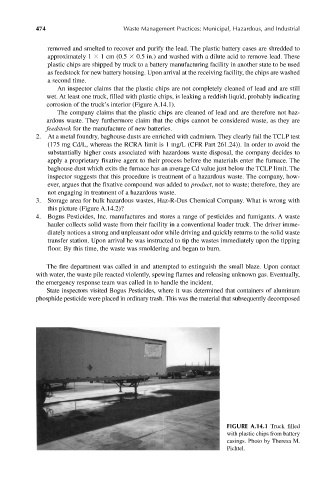Page 503 - Materials Chemistry, Second Edition
P. 503
CAT3525_C14.qxd 1/27/2005 12:37 PM Page 474
474 Waste Management Practices: Municipal, Hazardous, and Industrial
removed and smelted to recover and purify the lead. The plastic battery cases are shredded to
approximately 1 1 cm (0.5 0.5 in.) and washed with a dilute acid to remove lead. These
plastic chips are shipped by truck to a battery manufacturing facility in another state to be used
as feedstock for new battery housing. Upon arrival at the receiving facility, the chips are washed
a second time.
An inspector claims that the plastic chips are not completely cleaned of lead and are still
wet. At least one truck, filled with plastic chips, is leaking a reddish liquid, probably indicating
corrosion of the truck’s interior (Figure A.14.1).
The company claims that the plastic chips are cleaned of lead and are therefore not haz-
ardous waste. They furthermore claim that the chips cannot be considered waste, as they are
feedstock for the manufacture of new batteries.
2. At a metal foundry, baghouse dusts are enriched with cadmium. They clearly fail the TCLP test
(175 mg Cd/L, whereas the RCRA limit is 1 mg/L (CFR Part 261.24)). In order to avoid the
substantially higher costs associated with hazardous waste disposal, the company decides to
apply a proprietary fixative agent to their process before the materials enter the furnace. The
baghouse dust which exits the furnace has an average Cd value just below the TCLP limit. The
inspector suggests that this procedure is treatment of a hazardous waste. The company, how-
ever, argues that the fixative compound was added to product, not to waste; therefore, they are
not engaging in treatment of a hazardous waste.
3. Storage area for bulk hazardous wastes, Haz-R-Dus Chemical Company. What is wrong with
this picture (Figure A.14.2)?
4. Bogus Pesticides, Inc. manufactures and stores a range of pesticides and fumigants. A waste
hauler collects solid waste from their facility in a conventional loader truck. The driver imme-
diately notices a strong and unpleasant odor while driving and quickly returns to the solid waste
transfer station. Upon arrival he was instructed to tip the wastes immediately upon the tipping
floor. By this time, the waste was smoldering and began to burn.
The fire department was called in and attempted to extinguish the small blaze. Upon contact
with water, the waste pile reacted violently, spewing flames and releasing unknown gas. Eventually,
the emergency response team was called in to handle the incident.
State inspectors visited Bogus Pesticides, where it was determined that containers of aluminum
phosphide pesticide were placed in ordinary trash. This was the material that subsequently decomposed
FIGURE A.14.1 Truck filled
with plastic chips from battery
casings. Photo by Theresa M.
Pichtel.

